Exploring Kierkegaard's Ideas on Truth, Faith, and Subjectivity
VerifiedAdded on 2022/09/26
|8
|1744
|49
Essay
AI Summary
This essay provides an in-depth analysis of Søren Kierkegaard's philosophical views, particularly focusing on his concept of truth and its relationship to subjectivity, faith, and knowledge. The essay begins with an introduction to Kierkegaard's existentialist philosophy, emphasizing his rejection of excessive formalism and his belief in the importance of subjective experience. The main body of the essay outlines the meaning and significance of Kierkegaard's statement, "objective uncertainty held fast in an appropriation-process of the most passionate inwardness is the truth," and explores his theory of knowledge, including the concept of the Leap of Faith. The essay then critically assesses Kierkegaard's claims, examining the epistemological arguments and the role of Christian faith in attaining truth. It also discusses the critical assessment of the claim that the reality of Christianity can be remembered through the energetic subjectivity of confidence. The essay concludes by summarizing Kierkegaard's ideas and highlighting the importance of rational analysis in understanding human existence. The essay references several scholarly articles to support its arguments.
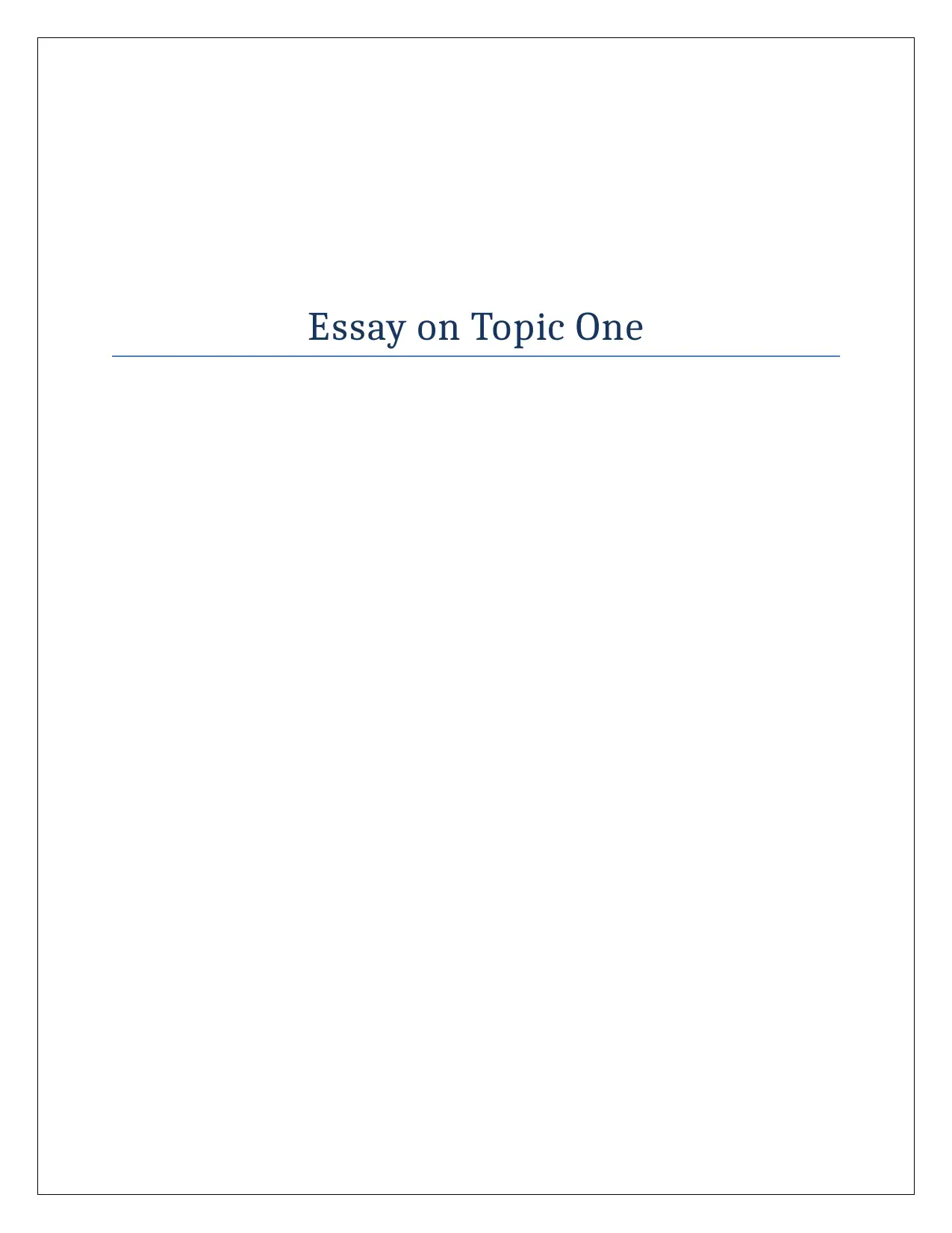
Essay on Topic One
Paraphrase This Document
Need a fresh take? Get an instant paraphrase of this document with our AI Paraphraser
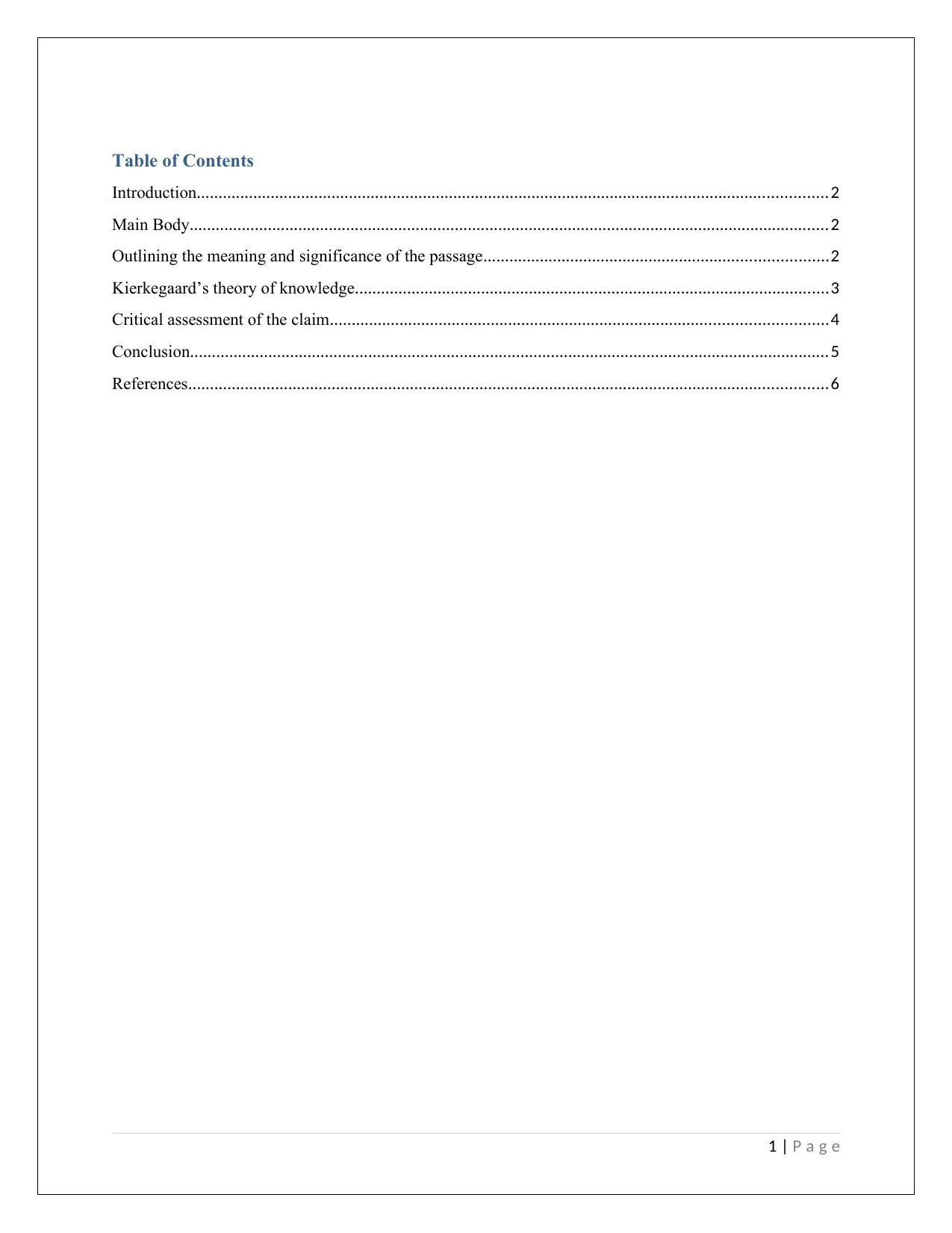
Table of Contents
Introduction.................................................................................................................................................2
Main Body...................................................................................................................................................2
Outlining the meaning and significance of the passage...............................................................................2
Kierkegaard’s theory of knowledge.............................................................................................................3
Critical assessment of the claim..................................................................................................................4
Conclusion...................................................................................................................................................5
References...................................................................................................................................................6
1 | P a g e
Introduction.................................................................................................................................................2
Main Body...................................................................................................................................................2
Outlining the meaning and significance of the passage...............................................................................2
Kierkegaard’s theory of knowledge.............................................................................................................3
Critical assessment of the claim..................................................................................................................4
Conclusion...................................................................................................................................................5
References...................................................................................................................................................6
1 | P a g e
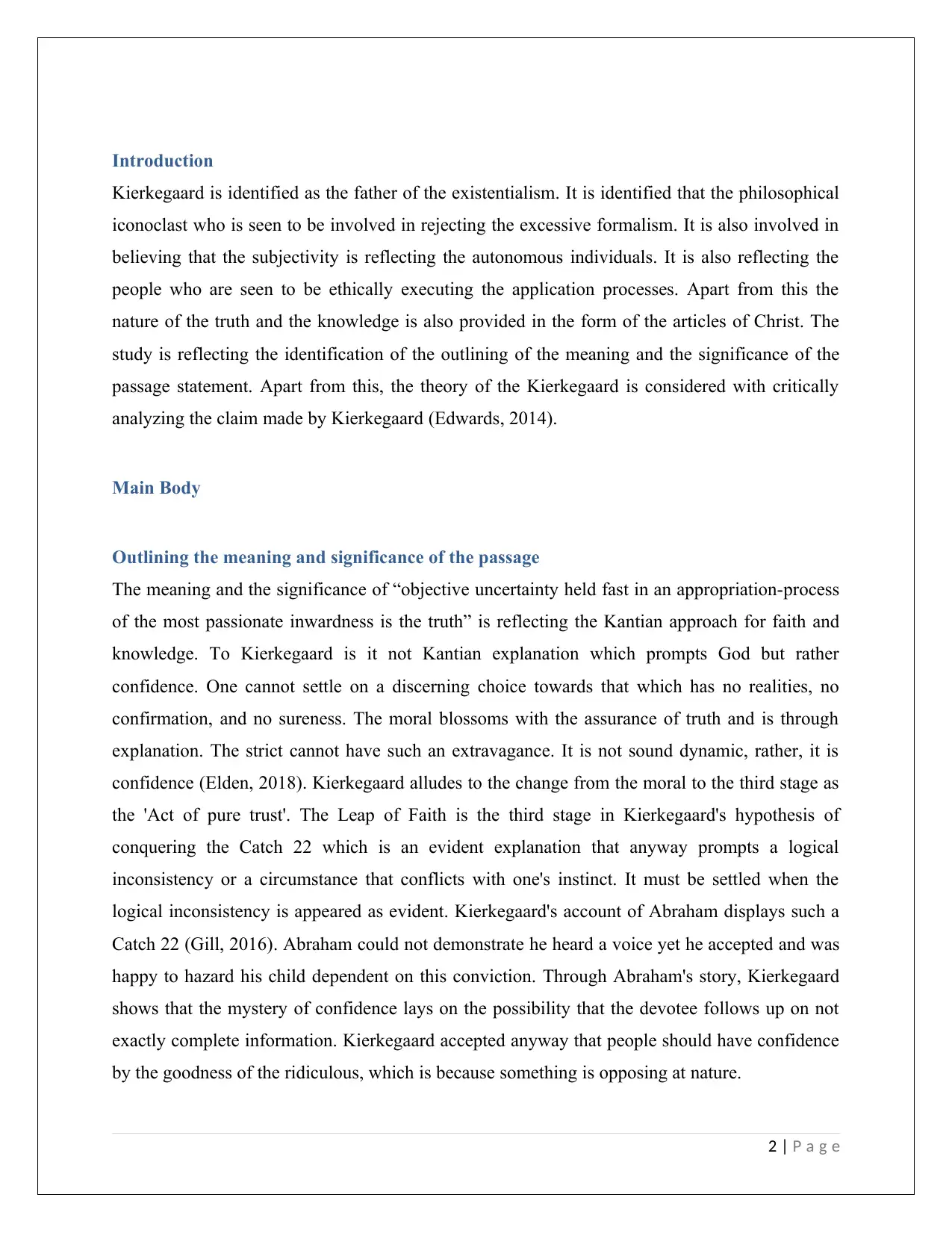
Introduction
Kierkegaard is identified as the father of the existentialism. It is identified that the philosophical
iconoclast who is seen to be involved in rejecting the excessive formalism. It is also involved in
believing that the subjectivity is reflecting the autonomous individuals. It is also reflecting the
people who are seen to be ethically executing the application processes. Apart from this the
nature of the truth and the knowledge is also provided in the form of the articles of Christ. The
study is reflecting the identification of the outlining of the meaning and the significance of the
passage statement. Apart from this, the theory of the Kierkegaard is considered with critically
analyzing the claim made by Kierkegaard (Edwards, 2014).
Main Body
Outlining the meaning and significance of the passage
The meaning and the significance of “objective uncertainty held fast in an appropriation-process
of the most passionate inwardness is the truth” is reflecting the Kantian approach for faith and
knowledge. To Kierkegaard is it not Kantian explanation which prompts God but rather
confidence. One cannot settle on a discerning choice towards that which has no realities, no
confirmation, and no sureness. The moral blossoms with the assurance of truth and is through
explanation. The strict cannot have such an extravagance. It is not sound dynamic, rather, it is
confidence (Elden, 2018). Kierkegaard alludes to the change from the moral to the third stage as
the 'Act of pure trust'. The Leap of Faith is the third stage in Kierkegaard's hypothesis of
conquering the Catch 22 which is an evident explanation that anyway prompts a logical
inconsistency or a circumstance that conflicts with one's instinct. It must be settled when the
logical inconsistency is appeared as evident. Kierkegaard's account of Abraham displays such a
Catch 22 (Gill, 2016). Abraham could not demonstrate he heard a voice yet he accepted and was
happy to hazard his child dependent on this conviction. Through Abraham's story, Kierkegaard
shows that the mystery of confidence lays on the possibility that the devotee follows up on not
exactly complete information. Kierkegaard accepted anyway that people should have confidence
by the goodness of the ridiculous, which is because something is opposing at nature.
2 | P a g e
Kierkegaard is identified as the father of the existentialism. It is identified that the philosophical
iconoclast who is seen to be involved in rejecting the excessive formalism. It is also involved in
believing that the subjectivity is reflecting the autonomous individuals. It is also reflecting the
people who are seen to be ethically executing the application processes. Apart from this the
nature of the truth and the knowledge is also provided in the form of the articles of Christ. The
study is reflecting the identification of the outlining of the meaning and the significance of the
passage statement. Apart from this, the theory of the Kierkegaard is considered with critically
analyzing the claim made by Kierkegaard (Edwards, 2014).
Main Body
Outlining the meaning and significance of the passage
The meaning and the significance of “objective uncertainty held fast in an appropriation-process
of the most passionate inwardness is the truth” is reflecting the Kantian approach for faith and
knowledge. To Kierkegaard is it not Kantian explanation which prompts God but rather
confidence. One cannot settle on a discerning choice towards that which has no realities, no
confirmation, and no sureness. The moral blossoms with the assurance of truth and is through
explanation. The strict cannot have such an extravagance. It is not sound dynamic, rather, it is
confidence (Elden, 2018). Kierkegaard alludes to the change from the moral to the third stage as
the 'Act of pure trust'. The Leap of Faith is the third stage in Kierkegaard's hypothesis of
conquering the Catch 22 which is an evident explanation that anyway prompts a logical
inconsistency or a circumstance that conflicts with one's instinct. It must be settled when the
logical inconsistency is appeared as evident. Kierkegaard's account of Abraham displays such a
Catch 22 (Gill, 2016). Abraham could not demonstrate he heard a voice yet he accepted and was
happy to hazard his child dependent on this conviction. Through Abraham's story, Kierkegaard
shows that the mystery of confidence lays on the possibility that the devotee follows up on not
exactly complete information. Kierkegaard accepted anyway that people should have confidence
by the goodness of the ridiculous, which is because something is opposing at nature.
2 | P a g e
⊘ This is a preview!⊘
Do you want full access?
Subscribe today to unlock all pages.

Trusted by 1+ million students worldwide
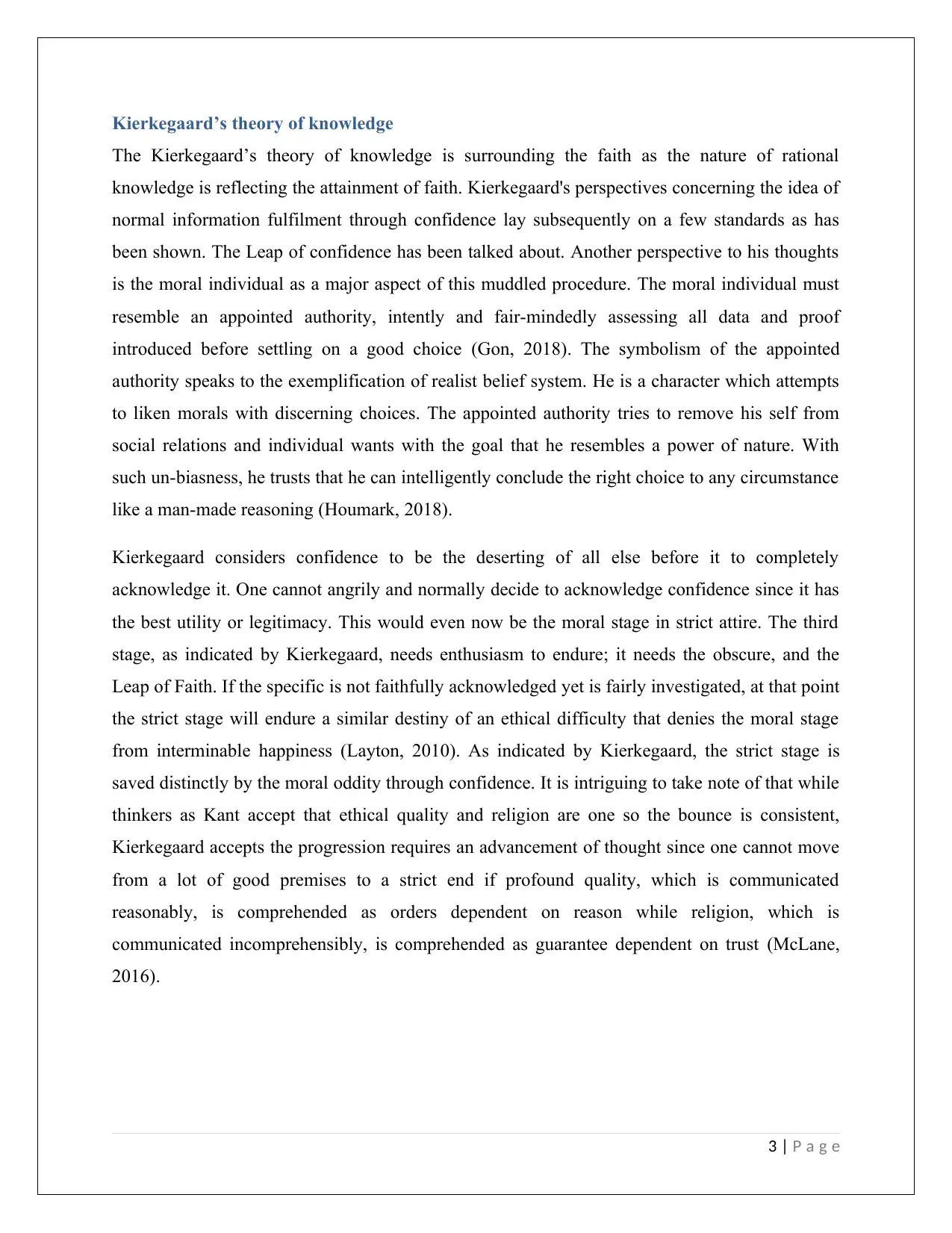
Kierkegaard’s theory of knowledge
The Kierkegaard’s theory of knowledge is surrounding the faith as the nature of rational
knowledge is reflecting the attainment of faith. Kierkegaard's perspectives concerning the idea of
normal information fulfilment through confidence lay subsequently on a few standards as has
been shown. The Leap of confidence has been talked about. Another perspective to his thoughts
is the moral individual as a major aspect of this muddled procedure. The moral individual must
resemble an appointed authority, intently and fair-mindedly assessing all data and proof
introduced before settling on a good choice (Gon, 2018). The symbolism of the appointed
authority speaks to the exemplification of realist belief system. He is a character which attempts
to liken morals with discerning choices. The appointed authority tries to remove his self from
social relations and individual wants with the goal that he resembles a power of nature. With
such un-biasness, he trusts that he can intelligently conclude the right choice to any circumstance
like a man-made reasoning (Houmark, 2018).
Kierkegaard considers confidence to be the deserting of all else before it to completely
acknowledge it. One cannot angrily and normally decide to acknowledge confidence since it has
the best utility or legitimacy. This would even now be the moral stage in strict attire. The third
stage, as indicated by Kierkegaard, needs enthusiasm to endure; it needs the obscure, and the
Leap of Faith. If the specific is not faithfully acknowledged yet is fairly investigated, at that point
the strict stage will endure a similar destiny of an ethical difficulty that denies the moral stage
from interminable happiness (Layton, 2010). As indicated by Kierkegaard, the strict stage is
saved distinctly by the moral oddity through confidence. It is intriguing to take note of that while
thinkers as Kant accept that ethical quality and religion are one so the bounce is consistent,
Kierkegaard accepts the progression requires an advancement of thought since one cannot move
from a lot of good premises to a strict end if profound quality, which is communicated
reasonably, is comprehended as orders dependent on reason while religion, which is
communicated incomprehensibly, is comprehended as guarantee dependent on trust (McLane,
2016).
3 | P a g e
The Kierkegaard’s theory of knowledge is surrounding the faith as the nature of rational
knowledge is reflecting the attainment of faith. Kierkegaard's perspectives concerning the idea of
normal information fulfilment through confidence lay subsequently on a few standards as has
been shown. The Leap of confidence has been talked about. Another perspective to his thoughts
is the moral individual as a major aspect of this muddled procedure. The moral individual must
resemble an appointed authority, intently and fair-mindedly assessing all data and proof
introduced before settling on a good choice (Gon, 2018). The symbolism of the appointed
authority speaks to the exemplification of realist belief system. He is a character which attempts
to liken morals with discerning choices. The appointed authority tries to remove his self from
social relations and individual wants with the goal that he resembles a power of nature. With
such un-biasness, he trusts that he can intelligently conclude the right choice to any circumstance
like a man-made reasoning (Houmark, 2018).
Kierkegaard considers confidence to be the deserting of all else before it to completely
acknowledge it. One cannot angrily and normally decide to acknowledge confidence since it has
the best utility or legitimacy. This would even now be the moral stage in strict attire. The third
stage, as indicated by Kierkegaard, needs enthusiasm to endure; it needs the obscure, and the
Leap of Faith. If the specific is not faithfully acknowledged yet is fairly investigated, at that point
the strict stage will endure a similar destiny of an ethical difficulty that denies the moral stage
from interminable happiness (Layton, 2010). As indicated by Kierkegaard, the strict stage is
saved distinctly by the moral oddity through confidence. It is intriguing to take note of that while
thinkers as Kant accept that ethical quality and religion are one so the bounce is consistent,
Kierkegaard accepts the progression requires an advancement of thought since one cannot move
from a lot of good premises to a strict end if profound quality, which is communicated
reasonably, is comprehended as orders dependent on reason while religion, which is
communicated incomprehensibly, is comprehended as guarantee dependent on trust (McLane,
2016).
3 | P a g e
Paraphrase This Document
Need a fresh take? Get an instant paraphrase of this document with our AI Paraphraser
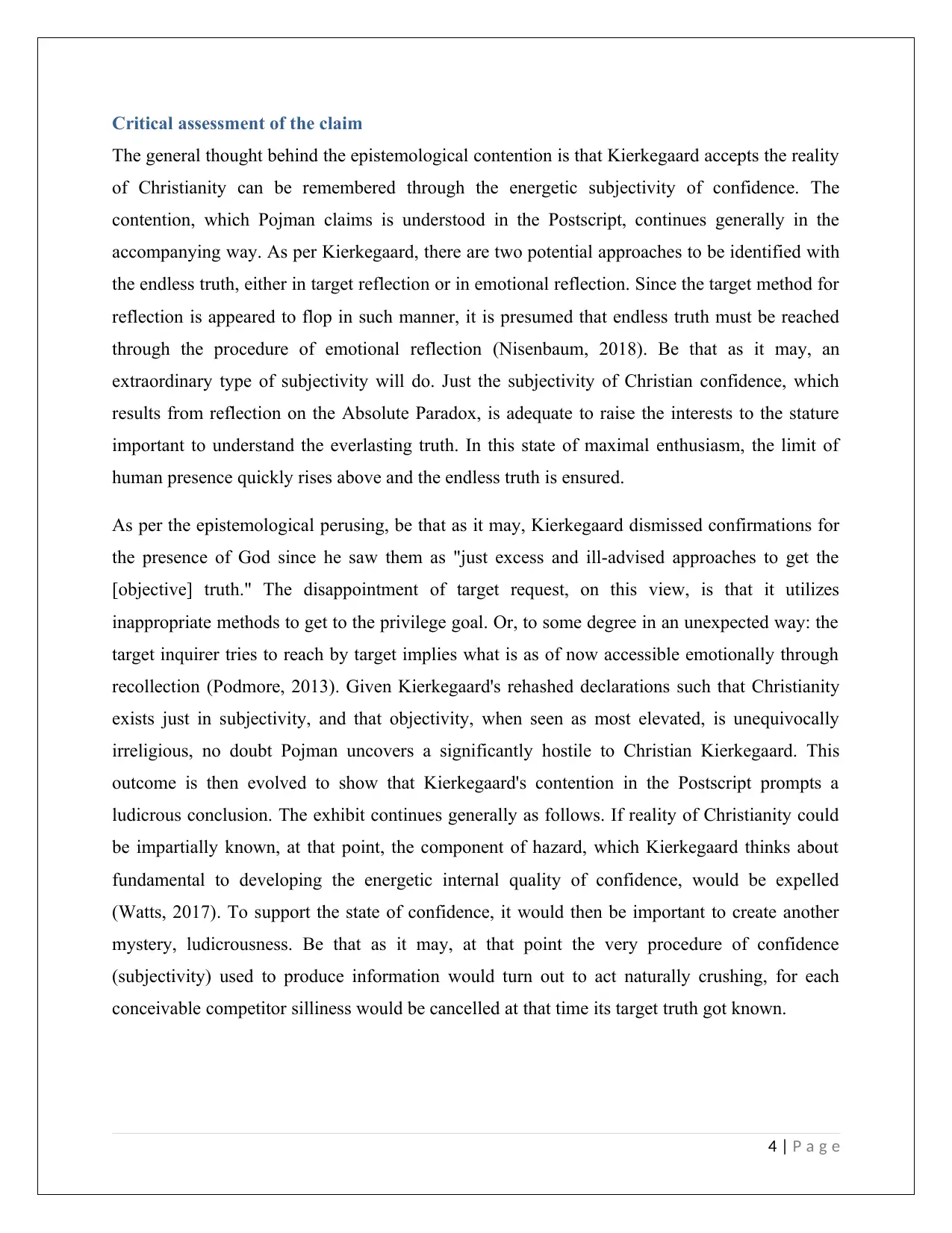
Critical assessment of the claim
The general thought behind the epistemological contention is that Kierkegaard accepts the reality
of Christianity can be remembered through the energetic subjectivity of confidence. The
contention, which Pojman claims is understood in the Postscript, continues generally in the
accompanying way. As per Kierkegaard, there are two potential approaches to be identified with
the endless truth, either in target reflection or in emotional reflection. Since the target method for
reflection is appeared to flop in such manner, it is presumed that endless truth must be reached
through the procedure of emotional reflection (Nisenbaum, 2018). Be that as it may, an
extraordinary type of subjectivity will do. Just the subjectivity of Christian confidence, which
results from reflection on the Absolute Paradox, is adequate to raise the interests to the stature
important to understand the everlasting truth. In this state of maximal enthusiasm, the limit of
human presence quickly rises above and the endless truth is ensured.
As per the epistemological perusing, be that as it may, Kierkegaard dismissed confirmations for
the presence of God since he saw them as "just excess and ill-advised approaches to get the
[objective] truth." The disappointment of target request, on this view, is that it utilizes
inappropriate methods to get to the privilege goal. Or, to some degree in an unexpected way: the
target inquirer tries to reach by target implies what is as of now accessible emotionally through
recollection (Podmore, 2013). Given Kierkegaard's rehashed declarations such that Christianity
exists just in subjectivity, and that objectivity, when seen as most elevated, is unequivocally
irreligious, no doubt Pojman uncovers a significantly hostile to Christian Kierkegaard. This
outcome is then evolved to show that Kierkegaard's contention in the Postscript prompts a
ludicrous conclusion. The exhibit continues generally as follows. If reality of Christianity could
be impartially known, at that point, the component of hazard, which Kierkegaard thinks about
fundamental to developing the energetic internal quality of confidence, would be expelled
(Watts, 2017). To support the state of confidence, it would then be important to create another
mystery, ludicrousness. Be that as it may, at that point the very procedure of confidence
(subjectivity) used to produce information would turn out to act naturally crushing, for each
conceivable competitor silliness would be cancelled at that time its target truth got known.
4 | P a g e
The general thought behind the epistemological contention is that Kierkegaard accepts the reality
of Christianity can be remembered through the energetic subjectivity of confidence. The
contention, which Pojman claims is understood in the Postscript, continues generally in the
accompanying way. As per Kierkegaard, there are two potential approaches to be identified with
the endless truth, either in target reflection or in emotional reflection. Since the target method for
reflection is appeared to flop in such manner, it is presumed that endless truth must be reached
through the procedure of emotional reflection (Nisenbaum, 2018). Be that as it may, an
extraordinary type of subjectivity will do. Just the subjectivity of Christian confidence, which
results from reflection on the Absolute Paradox, is adequate to raise the interests to the stature
important to understand the everlasting truth. In this state of maximal enthusiasm, the limit of
human presence quickly rises above and the endless truth is ensured.
As per the epistemological perusing, be that as it may, Kierkegaard dismissed confirmations for
the presence of God since he saw them as "just excess and ill-advised approaches to get the
[objective] truth." The disappointment of target request, on this view, is that it utilizes
inappropriate methods to get to the privilege goal. Or, to some degree in an unexpected way: the
target inquirer tries to reach by target implies what is as of now accessible emotionally through
recollection (Podmore, 2013). Given Kierkegaard's rehashed declarations such that Christianity
exists just in subjectivity, and that objectivity, when seen as most elevated, is unequivocally
irreligious, no doubt Pojman uncovers a significantly hostile to Christian Kierkegaard. This
outcome is then evolved to show that Kierkegaard's contention in the Postscript prompts a
ludicrous conclusion. The exhibit continues generally as follows. If reality of Christianity could
be impartially known, at that point, the component of hazard, which Kierkegaard thinks about
fundamental to developing the energetic internal quality of confidence, would be expelled
(Watts, 2017). To support the state of confidence, it would then be important to create another
mystery, ludicrousness. Be that as it may, at that point the very procedure of confidence
(subjectivity) used to produce information would turn out to act naturally crushing, for each
conceivable competitor silliness would be cancelled at that time its target truth got known.
4 | P a g e
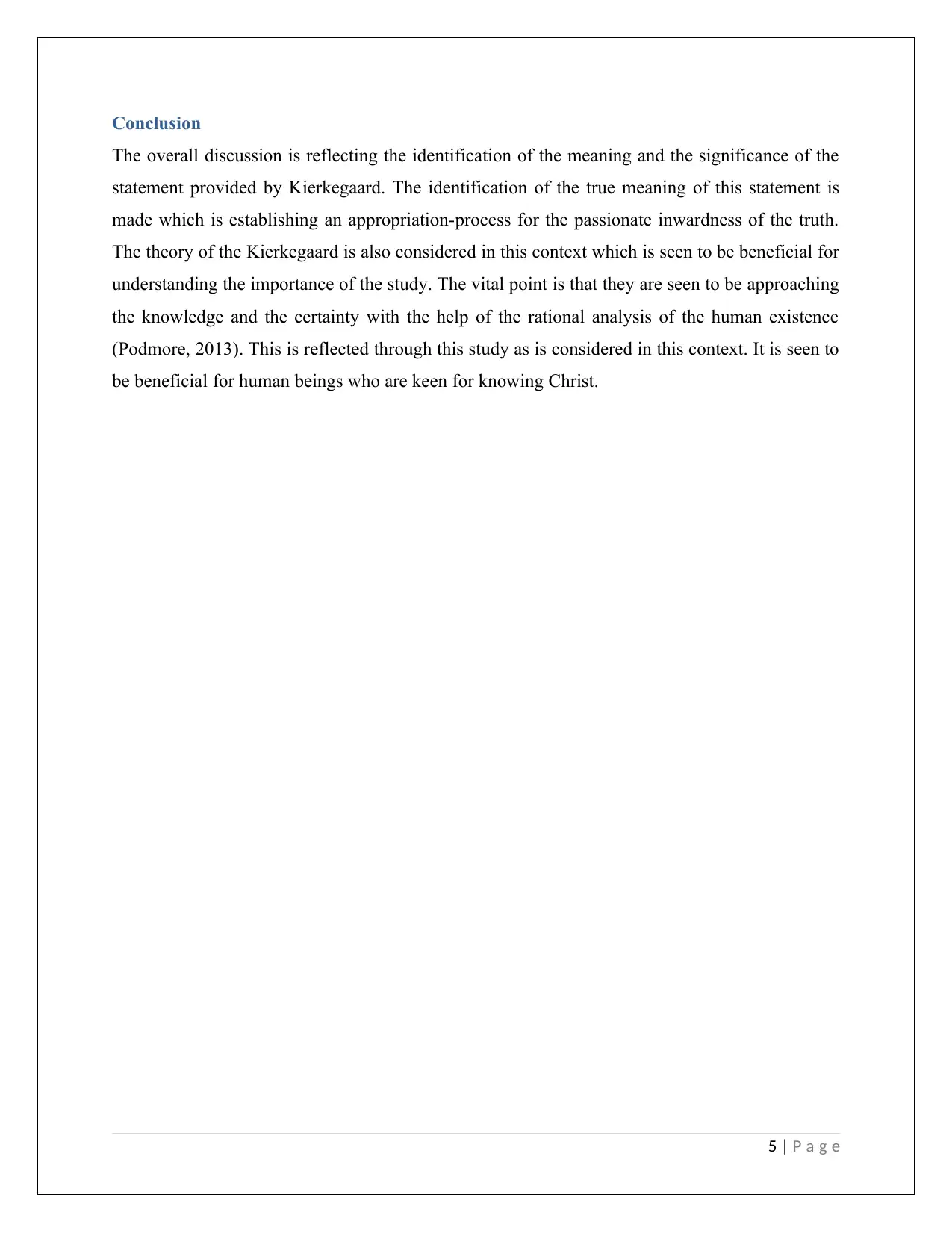
Conclusion
The overall discussion is reflecting the identification of the meaning and the significance of the
statement provided by Kierkegaard. The identification of the true meaning of this statement is
made which is establishing an appropriation-process for the passionate inwardness of the truth.
The theory of the Kierkegaard is also considered in this context which is seen to be beneficial for
understanding the importance of the study. The vital point is that they are seen to be approaching
the knowledge and the certainty with the help of the rational analysis of the human existence
(Podmore, 2013). This is reflected through this study as is considered in this context. It is seen to
be beneficial for human beings who are keen for knowing Christ.
5 | P a g e
The overall discussion is reflecting the identification of the meaning and the significance of the
statement provided by Kierkegaard. The identification of the true meaning of this statement is
made which is establishing an appropriation-process for the passionate inwardness of the truth.
The theory of the Kierkegaard is also considered in this context which is seen to be beneficial for
understanding the importance of the study. The vital point is that they are seen to be approaching
the knowledge and the certainty with the help of the rational analysis of the human existence
(Podmore, 2013). This is reflected through this study as is considered in this context. It is seen to
be beneficial for human beings who are keen for knowing Christ.
5 | P a g e
⊘ This is a preview!⊘
Do you want full access?
Subscribe today to unlock all pages.

Trusted by 1+ million students worldwide
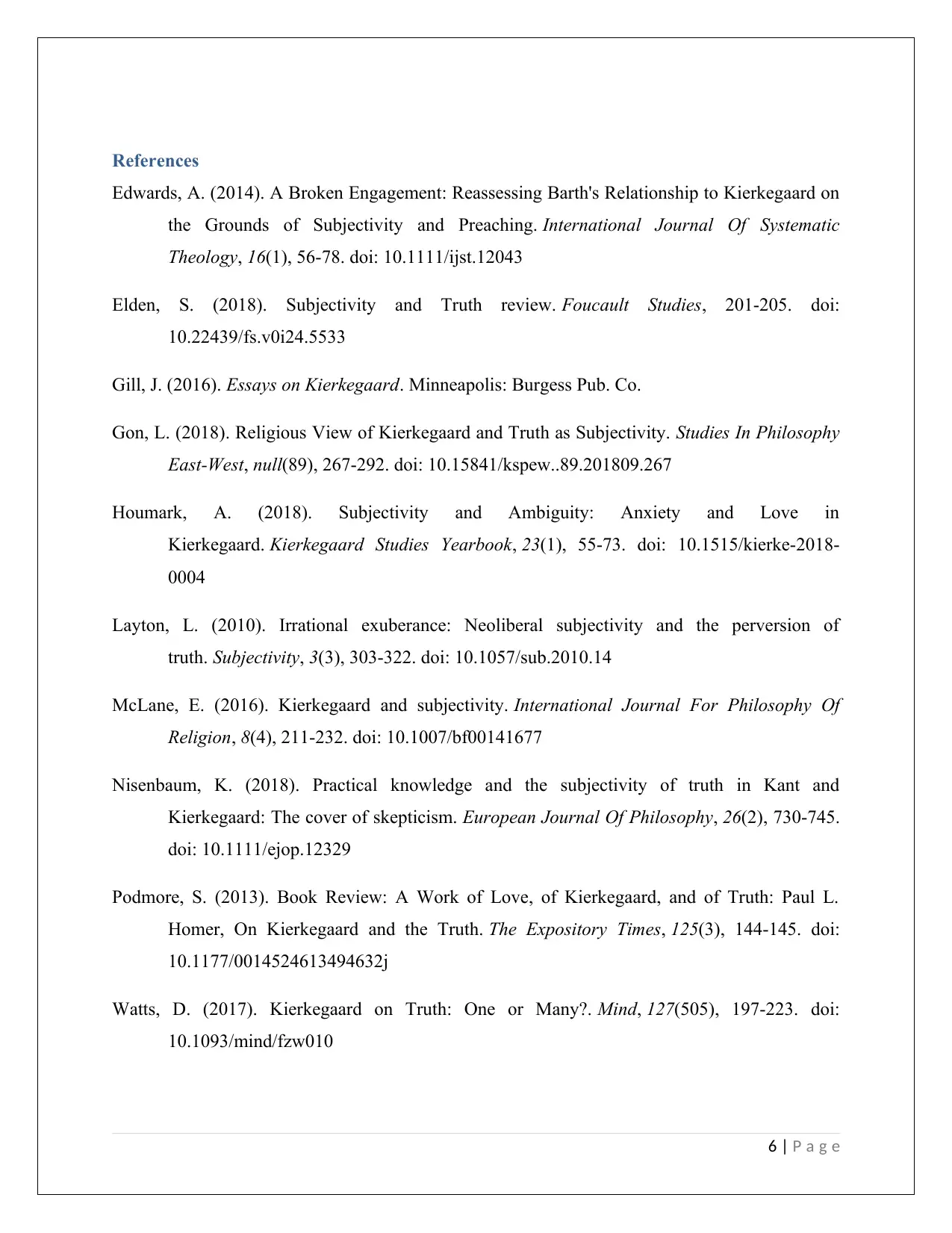
References
Edwards, A. (2014). A Broken Engagement: Reassessing Barth's Relationship to Kierkegaard on
the Grounds of Subjectivity and Preaching. International Journal Of Systematic
Theology, 16(1), 56-78. doi: 10.1111/ijst.12043
Elden, S. (2018). Subjectivity and Truth review. Foucault Studies, 201-205. doi:
10.22439/fs.v0i24.5533
Gill, J. (2016). Essays on Kierkegaard. Minneapolis: Burgess Pub. Co.
Gon, L. (2018). Religious View of Kierkegaard and Truth as Subjectivity. Studies In Philosophy
East-West, null(89), 267-292. doi: 10.15841/kspew..89.201809.267
Houmark, A. (2018). Subjectivity and Ambiguity: Anxiety and Love in
Kierkegaard. Kierkegaard Studies Yearbook, 23(1), 55-73. doi: 10.1515/kierke-2018-
0004
Layton, L. (2010). Irrational exuberance: Neoliberal subjectivity and the perversion of
truth. Subjectivity, 3(3), 303-322. doi: 10.1057/sub.2010.14
McLane, E. (2016). Kierkegaard and subjectivity. International Journal For Philosophy Of
Religion, 8(4), 211-232. doi: 10.1007/bf00141677
Nisenbaum, K. (2018). Practical knowledge and the subjectivity of truth in Kant and
Kierkegaard: The cover of skepticism. European Journal Of Philosophy, 26(2), 730-745.
doi: 10.1111/ejop.12329
Podmore, S. (2013). Book Review: A Work of Love, of Kierkegaard, and of Truth: Paul L.
Homer, On Kierkegaard and the Truth. The Expository Times, 125(3), 144-145. doi:
10.1177/0014524613494632j
Watts, D. (2017). Kierkegaard on Truth: One or Many?. Mind, 127(505), 197-223. doi:
10.1093/mind/fzw010
6 | P a g e
Edwards, A. (2014). A Broken Engagement: Reassessing Barth's Relationship to Kierkegaard on
the Grounds of Subjectivity and Preaching. International Journal Of Systematic
Theology, 16(1), 56-78. doi: 10.1111/ijst.12043
Elden, S. (2018). Subjectivity and Truth review. Foucault Studies, 201-205. doi:
10.22439/fs.v0i24.5533
Gill, J. (2016). Essays on Kierkegaard. Minneapolis: Burgess Pub. Co.
Gon, L. (2018). Religious View of Kierkegaard and Truth as Subjectivity. Studies In Philosophy
East-West, null(89), 267-292. doi: 10.15841/kspew..89.201809.267
Houmark, A. (2018). Subjectivity and Ambiguity: Anxiety and Love in
Kierkegaard. Kierkegaard Studies Yearbook, 23(1), 55-73. doi: 10.1515/kierke-2018-
0004
Layton, L. (2010). Irrational exuberance: Neoliberal subjectivity and the perversion of
truth. Subjectivity, 3(3), 303-322. doi: 10.1057/sub.2010.14
McLane, E. (2016). Kierkegaard and subjectivity. International Journal For Philosophy Of
Religion, 8(4), 211-232. doi: 10.1007/bf00141677
Nisenbaum, K. (2018). Practical knowledge and the subjectivity of truth in Kant and
Kierkegaard: The cover of skepticism. European Journal Of Philosophy, 26(2), 730-745.
doi: 10.1111/ejop.12329
Podmore, S. (2013). Book Review: A Work of Love, of Kierkegaard, and of Truth: Paul L.
Homer, On Kierkegaard and the Truth. The Expository Times, 125(3), 144-145. doi:
10.1177/0014524613494632j
Watts, D. (2017). Kierkegaard on Truth: One or Many?. Mind, 127(505), 197-223. doi:
10.1093/mind/fzw010
6 | P a g e
Paraphrase This Document
Need a fresh take? Get an instant paraphrase of this document with our AI Paraphraser

7 | P a g e
1 out of 8
Your All-in-One AI-Powered Toolkit for Academic Success.
+13062052269
info@desklib.com
Available 24*7 on WhatsApp / Email
![[object Object]](/_next/static/media/star-bottom.7253800d.svg)
Unlock your academic potential
Copyright © 2020–2025 A2Z Services. All Rights Reserved. Developed and managed by ZUCOL.